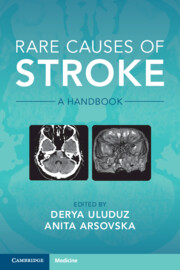Book contents
- Rare Causes of Stroke
- Rare Causes of Stroke
- Copyright page
- Contents
- Contributors
- Preface
- 1 Inflammatory Conditions
- 2 Infectious and Postinfectious Vasculitis
- 3 Hypercoagulable Causes of Stroke
- Chapter 3.1 Antiphospholipid Antibody Syndrome
- Chapter 3.2 Hyperhomocysteinemia
- Chapter 3.3 Hyperviscosity Syndrome
- Chapter 3.4 Disseminated Intravascular Coagulation and Moschkowitz Syndrome
- Chapter 3.5 Immunoglobulin A Vasculitis (Henoch–Schönlein Purpura)
- Chapter 3.6 Stroke Associated With Cancer
- 4 Drug-Related Stroke
- 5 Hereditary and Genetic Causes of Stroke
- 6 Rare Causes of Cardioembolism
- 7 Vasospastic Conditions and Other Vasculopathies
- 8 Other Non-inflammatory Vasculopathies
- 9 Venous Occlusive Conditions
- 10 Bone Disorders and Stroke
- Index
- References
Chapter 3.4 - Disseminated Intravascular Coagulation and Moschkowitz Syndrome
from 3 - Hypercoagulable Causes of Stroke
Published online by Cambridge University Press: 06 October 2022
- Rare Causes of Stroke
- Rare Causes of Stroke
- Copyright page
- Contents
- Contributors
- Preface
- 1 Inflammatory Conditions
- 2 Infectious and Postinfectious Vasculitis
- 3 Hypercoagulable Causes of Stroke
- Chapter 3.1 Antiphospholipid Antibody Syndrome
- Chapter 3.2 Hyperhomocysteinemia
- Chapter 3.3 Hyperviscosity Syndrome
- Chapter 3.4 Disseminated Intravascular Coagulation and Moschkowitz Syndrome
- Chapter 3.5 Immunoglobulin A Vasculitis (Henoch–Schönlein Purpura)
- Chapter 3.6 Stroke Associated With Cancer
- 4 Drug-Related Stroke
- 5 Hereditary and Genetic Causes of Stroke
- 6 Rare Causes of Cardioembolism
- 7 Vasospastic Conditions and Other Vasculopathies
- 8 Other Non-inflammatory Vasculopathies
- 9 Venous Occlusive Conditions
- 10 Bone Disorders and Stroke
- Index
- References
Summary
Disseminated intravascular coagulation (DIC) is an acquired syndrome characterized by intravascular coagulation activation, which can arise from different causes. The diagnosis of DIC is based on a combination of clinical features, underlying condition and laboratory testing. Neurologic manifestations of DIC result in either cerebral thromboses or bleeding. Seizures, hemiparesis, aphasia, visual field disorders are common clinical signs. In the treatment of DIC, the first step would be to treat the underlying causes and thrombotic or haemorrhagic complications. Treatment with low-molecular-weight heparin in DIC may be preferred to unfractionated heparin in DIC with thrombotic complications.Thrombotic thrombocytopenic purpura (TTP) is the most common type of thrombotic microangiopathy. Pathophysiology of the acquired TTP (Moschkowitz syndrome) is combined with an increase of Willebrand factor due to a congenital or acquired deficiency of its cleaving metalloprotease (ADAMTS13). The causes of secondary Moschkowitz syndrome can be drug-associated, pregnant and postpartum patients and those with HIV or systemic autoimmune diseases. Diagnostic pentad of clinical manifestations includes microangiopathic haemolytic anaemia, severe thrombocytopenia, fever, renal involvement and various neurologic symptoms. Brain CT or MRI usually reveals small and multiple ischemic lesions, involving different arterial territories in both anterior and posterior circulations. Plasma exchange therapy, corticosteroid therapy, and rituximab (refractory or relapsed forms of the disease) are effective in patients with TTP. Oral aspirin may be prescribed at a preventive dose range until the termination of corticosteroid use
Keywords
- Type
- Chapter
- Information
- Rare Causes of StrokeA Handbook, pp. 168 - 173Publisher: Cambridge University PressPrint publication year: 2022



